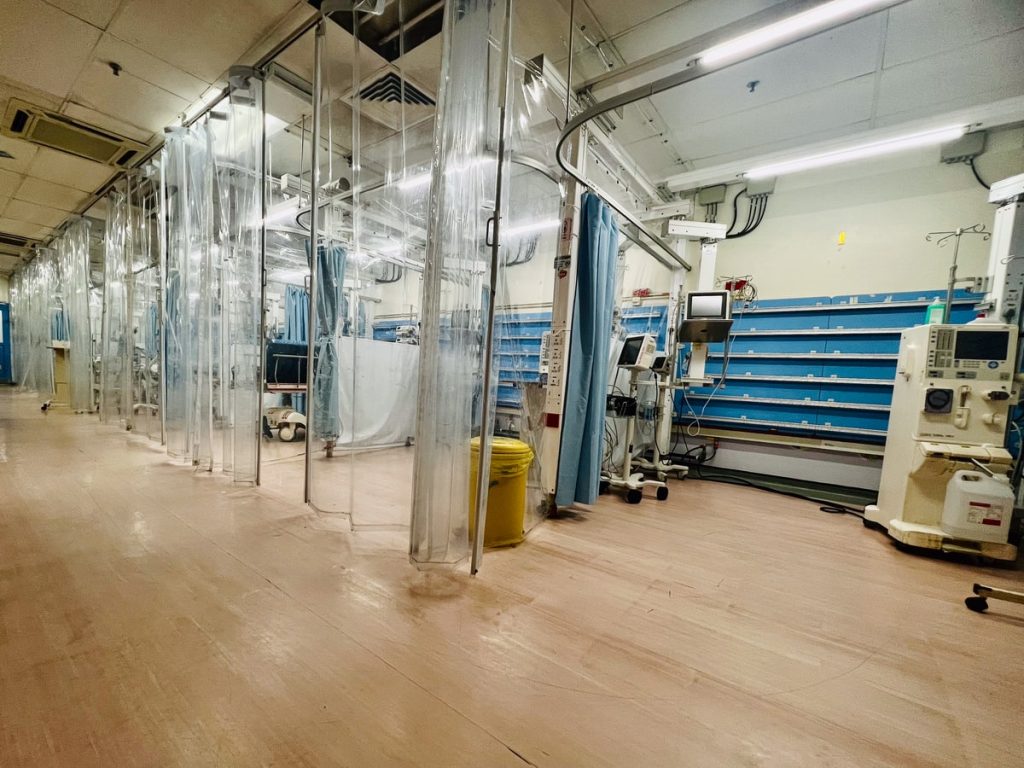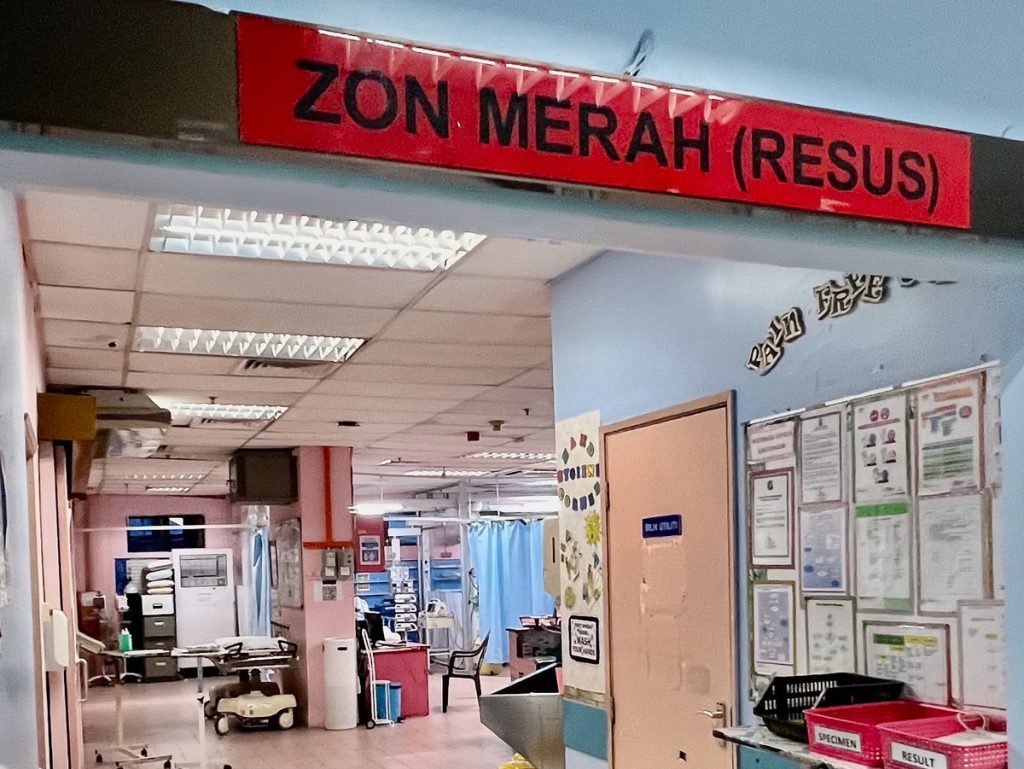KUALA LUMPUR, July 25 – Emergency doctors at Kuala Lumpur Hospital (HKL) have been pulling double, and at times triple, shifts for nearly two months, as they prepare to lose more medical staff by month-end.
HKL’s emergency and trauma department (ETD), one of the nation’s busiest, is expected to lose 15 trained medical officers in the July 31 relocation, with over 20 “floating” officers (medical officers who just completed their housemanship) having left in June, as part of the Ministry of Health’s (MOH) plan to fill the void left by the upcoming doctor relocation exercise.
This means that in just two months, HKL’s ETD has seen the departure of about 40 medical staff members, with no immediate replacements in sight.
Overall, HKL is expected to lose a whopping 300 trained medical officers to the massive relocation of over 4,100 contract medical officers for permanent appointments. The tertiary referral centre will receive only 100 medical officers from placements via the eHousemen system, which translates to a net loss of 200 doctors.
Among the incoming 100 officers, priority will likely be given to HKL’s medical department, which a source within the hospital described as “dying” due to its high turnover rate.
“The turnover rate at the medical department is very high, with one to two medical officers leaving per day, including those who quit, because the work burden is very high,” Dr Daniel (pseudonym) told CodeBlue last July 16. “It’s very likely that the medical department will be given priority when it comes to getting more staff.”
In January, HKL director Dr Rohana Johan revealed that the MOH hospital employs a total of 12,000 staff. However, despite the sizeable workforce, Dr Rohana said it is “barely enough” for a hospital of HKL’s magnitude.
HKL, the country’s largest tertiary hospital, has 53 departments and units. The public hospital’s emergency department alone has up to 10 emergency zones, including two Red Zones for critical cases, extension wards to accommodate high patient volumes, and isolation rooms for critically ill patients awaiting intensive care unit (ICU) beds.
HKL Patients Stranded At Least One To Two Days In ED For Ward Admission, Wait Up To Four Days For ICU Beds

Given HKL’s status as the country’s premier referral centre, Dr Daniel said it is “impossible” for the hospital to cut down its services, especially as ongoing renovations have compelled the hospital to operate at only half its capacity.
“We take referrals from every state, so it is not possible for us to shut down or reduce any of the services,” said Dr Daniel. “The only option we have, instead of cutting services, is to increase the workload on existing staff – and this will only lead to more burnouts and staff resignations, and patients will experience even longer waiting times than they already do.”
At HKL’s emergency department, waiting times to be seen by a doctor can range from three to six hours, depending on the crowd. The waiting time for blood test results or X-ray scans can take a couple more hours on a busy day – that is, if they are not overlooked by medical staff.
Patients waiting for ward admission can be stranded in the ETD for at least one to two days, while those needing ICU beds can wait up to four days due to limited beds.
As a result, HKL’s ETD has an entire observation unit, which includes a negative pressure room for patients requiring high oxygen support, observation rooms for dengue patients who are unstable and need hourly monitoring, as well as isolation rooms for patients with chronic kidney diseases requiring dialysis – all awaiting beds in wards or ICUs.
“The emergency department here is different from other ETDs because we have patients who are stranded here for three to four days; they can’t go up to the wards. So, we’re doing ICU work, nephrology work here, because the nephrology ward is also always full.
“We can’t just force them (patients) into the wards because they are critically ill. Some need to be dialysed, so we will dialyse them in the emergency department,” Dr Daniel said.
“In other words, all emergency officers need to know how to take care of ICU patients and dialysed patients,” Dr Daniel added. “This is partly what I like about HKL; we learn a lot.”
In Red Zone, One MO to Seven Patients; In Yellow Zone, One MO to 17 Patients

Apart from the observation unit, HKL’s ETD has two distinct Red Zones: one for critically ill patients with respiratory diseases, including Covid-19, and another for critically ill patients with non-respiratory diseases like heart disease or trauma cases.
Each Red Zone has a capacity of over 20 beds. However, on days with high patient volume, patients may be accommodated on wheelchairs, or on plastic chairs if wheelchairs become unavailable. In each Red Zone, there are usually three medical officers attending to patients.
“For example, if there are 22 beds in Red Zone 1, one medical officer will be in charge of seven critically ill patients,” Dr Daniel said.
HKL’s Yellow Zone (Semi-Critical Zone) has double the bed capacity and can accommodate up to 50 beds at a time, making it the busiest emergency zone. Patients in the Yellow Zone are neither too critical nor completely stable, and may need observation for 12 hours or more, depending on their condition. This often leads to congestion in the ETD.
“Before the renovations, the Yellow Zone could accommodate up to 70 to 80 patients. But with renovations, this is the capacity we have now. On weekdays, it will be completely filled. The worst part is everyone will be queuing, and sometimes we will have beds along the corridors.
“Patients have no choice but to wait for us to attend to them one by one,” Dr Daniel said.
Similar to the Red Zone, the Yellow Zone will also have three medical officers attending to patients. But with up to 50 beds, doctors are stretched across more patients, translating to about one doctor to 17 patients.
In Green Zone, Doctor Sees 40 Patients In One Shift; Up to 80 Patients in Double Shift

At the Green Zone (Non-Critical Zone) in HKL’s emergency department, the average waiting time is approximately three to four hours, sometimes longer, depending on patient traffic. The Green Zone, which has no air-conditioning, has five open cubicles with one doctor assigned to each.
It also has a small procedure room, located around the back for common procedures such as wound suturing, laceration repair, abscess drainage, and other interventions to stabilise and manage patients with acute medical conditions or injuries.
“In one shift, one doctor can attend up to 40 patients. If it’s a double shift, then it can go up to about 80 patients in a day. With five cubicles, that amounts to about 400 patients a day, just at the Green Zone, on a weekday,” Dr Daniel said. HKL’s emergency department has three shifts: morning (8am to 3pm), evening (3pm to 10pm), and night (10pm to 8am).
The opening of the HKL MRT station in March this year has expanded HKL ETD’s reach to include patients not only from the city centre, but those from Selayang and Serdang. Many patients from these areas have claimed that HKL’s ETD provides faster service.
“I’m not sure how true that is, but it could be because our ETD is bigger, which might make us slightly faster,” Dr Daniel said.
HKL’s top management and Health Minister Dr Zaliha Mustafa’s office did not respond to CodeBlue’s queries about HKL’s situation.
On weekdays, overcrowding at the emergency department often leads to long queues, with people standing or sitting at designated areas – including patients on wheelchairs – next to a busy road.
This is consistent with the Auditor-General’s 2018 report, which disclosed that ETDs, specifically, in public hospitals were understaffed, overcrowded, and underfunded.
Like many of his colleagues, Dr Daniel hopes that there will be a grace period of at least one to three months from the letter of transfer to the reporting date for all doctors affected by the relocation. This would help ease the disruptions caused by doctor relocations.
Dr Daniel also wants the MOH to provide real-time data, updated periodically, on health manpower in its hospitals.
“At the moment, our head of department has been very supportive by doing clinical work as well. Our specialists have also been pulling their weight and working double shifts to share the burden,” Dr Daniel said. “But it is what it is; we are simply managing, not thriving.”








